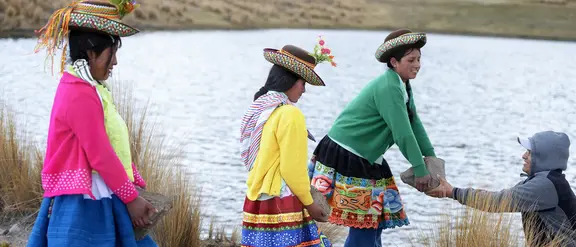Peru: Indigenes Water Management in the Andes
Glacier melt, weather extreme and drought: The consequences of climate change make it difficult for the farmers in the Andes. The municipality of Quispillacta is comparatively well prepared because it has long been familiar with the ecological knowledge of its ancestors.
Magdalena Machaca is worried. Climate change has meant that farmers in the Andes have to contend with large temperature fluctuations and the glaciers are melting. "We live in the mountains," she says, "the snow up there has always been our natural source of water. During the dry season, we rely on the streams and springs that form when the thaws. But many mountains are no longer snow-covered." Magdalena Machaca is an agricultural scientist, and Quispillacta – 13 hamlets at an altitude of 2,500 to 4,500 meters – is her home. After completing her studies, she returned there and, together with her sister Marcela Machaca, founded the Bartolomé Aripaylla Association, or ABA for short, in 1991. Just one year later, they received support from Terre des Hommes .
The Machaca sisters primarily rely on the traditional ecological knowledge of the Indian communities in order to improve water supply, to make certain properties of plants usable and thus improve the yields of the peasant families. "We spoke to the elders to find solutions to the problem of drought times," recalls Magdalena Machaca. »And we discovered the Qucha Ruway - a practice that enables rainwater to store in lagoons and at the same time maintain nature and biological diversity. We use clay, stones and plant material for the dams. Certain algae promote infiltration. Everyone helps with construction, including the young people and the children. «
Defy the consequences of climate change
In the meantime, ABA has created more than 120 ponds together with the village communities and attached the banks so that the fall rain can be collected. The water seeps into the deeper layers of the mountain and fills the groundwater memory. With its long roots, the Putaqa plant can pull the groundwater to the surface where it is needed. Many families have created such a "Putaqa source". "The lakes can at least partially replace the ecological function of the disappeared glaciers," says Magdalena proudly. »This means that the farmer families can also maintain their food production in drought. We have become more resilient against climate change. "
Thanks to ABA, the topic of rainwater harvesting has also entered Peruvian politics. Several regional governments, which not so long ago frowned upon traditional knowledge and relied solely on mechanized agricultural methods, have recognized the success of the measures and decided to implement the ABA concept in other parts of Peru. Thus, the work of ABA and Terre des Hommes has an impact far beyond Quispillacta.
